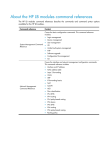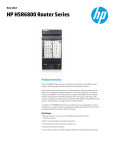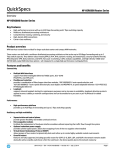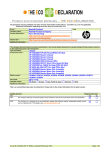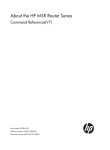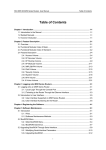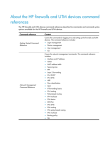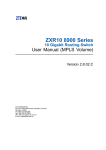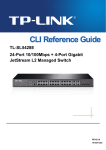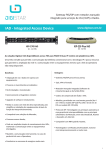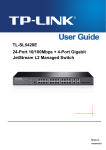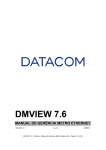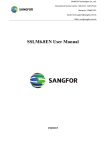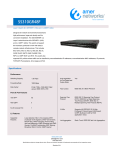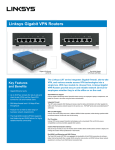Download HP HSR6800 Command Reference Guide
Transcript
About the HP HSR6800 Command References The HP HSR6800 command references are part of the HP HSR6800 Routers documentation set. They describe the commands and command syntax options available for the HP HSR6800 Routers. The HP HSR6800 documentation set includes 12 command references: Command reference Content Fundamentals Command Reference Covers the commands for logging in to and setting up an HSR6800 Router. This command reference includes: • CLI • Logging In to the Router • FTP and TFTP • File Management • Configuration File Management • Software Upgrade • Device Management Interface Command Reference Covers the interface configuration commands. This command reference includes: • Ethernet Interface • ATM Interface • WAN Interface • POS Interface • CPOS Interface • E-CPOS Interface • Loopback and Null Interface Layer 2 – LAN Switching Command Reference Covers the commands for configuring Layer 2 technologies and features in a LAN switched network. This command reference includes: • MAC Address Table • Ethernet Link Aggregation • Port Isolation • MSTP • BPDU Tunneling • VLAN • GVRP • QinQ • VLAN Termination • VLAN Mapping • LLDP Layer 2 – WAN Access Command Reference Covers WAN access technologies. This command reference includes: Layer 3 – IP Services Command Reference Covers the commands for configuring and managing IP addressing (including static and dynamic IPv4 and IPv6 address assignment), network • ATM • PPP • L2TP • HDLC • Frame Relay • Modem Management performance optimization, ARP, and interoperation between IPv4 and IPv6. This command reference includes: • • • • • • • • • • • • • • • • • • Layer 3 – IP Routing Command Reference ARP IP Addressing DHCP DNS NAT IP Forwarding Basics Flow Classification Adjacency Table IP Performance Optimization UDP Helper IPv6 Basics DHCPv6 IPv6 DNS NPT AFT Tunneling GRE DVPN Covers the commands for configuring routes for IPv4 and IPv6 networks of different sizes, route filtering, route control, and policy based routing. This command reference includes: • IP Routing Basics • Static Routing • RIP • OSPF • IS-IS • BGP • PoliBased Routing • IPv6 Static Routing • RIPng • OSPFv3 • IPv6 IS-IS • IPv6 BGP • IPv6 PoliBased Routing • Routing Policy • MTR IP Multicast Command Reference Covers the commands for Layer 3 IPv4 multicast protocols IGMP, PIM, MBGP, and Layer 3 IPv6 multicast protocols MLD, IPv6 PIM, MSDP, and IPv6 MBGP), Layer 2 IPv4 multicast protocols (IGMP snooping). This command reference includes: • IGMP Snooping • Multicast Routing and Forwarding • IGMP • PIM • MSDP • MBGP • Multicast VPN • IPv6 Multicast Routing and Forwarding • MLD • IPv6 PIM • IPv6 MBGP • PIM Snooping • Multicast VLAN MPLS Command Reference Describes the commands to configure MPLS and MPLS VPN, This command reference includes: • MPLS Basics • MPLS TE • MPLS L2VPN • VPLS • MPLS L3VPN ACL and QoS Command Reference Covers the commands for classifying traffic with ACLs, and allocating network resources and managing congestions with QoS technologies to improve network performance and network use efficiency. This command reference includes: • ACL • QoS • MPLS QoS • FR QoS Security Command Reference Covers security feature commands. Available security features include identity authentication (AAA), access security (802.1X, MAC authentication, and portal), secure management (SSH), and attack protection (Firewall, TCP and ICMP Attack Protection, ARP attack protection, ARP Attack Protection, ND Attack Defense and URPF). This command reference includes: • • • • • • • • • • • • • • • • • • • • • • AAA 802.1X MAC Authentication Portal Port Security User Profile Password Control RSH Public Key PKI IPsec SSH2.0 Firewall ALG Session Management Connection Limit Web Filtering Attack Detection and Protection TCP and ICMP Attack Protection IP Source Guard ARP Attack Protection ND Attack Defense • URPF • FIPS High Availability Command Reference Covers high availability commands for managing failure detection and failover. Failure detection technologies focus on fault detection and isolation. Failover technologies focus on network recovery. This command reference includes: • Active and Standby Switchover • Ethernet OAM • CFD • DLDP • RPR • RRPP • Smart Link • VRRP • BFD • Track Network Management and Monitoring Command Reference Covers the commands that help you manage and monitor your network, for example, manage system events, collect traffic statistics, sample packets, assess network performance, and test network connectivity. This command reference includes: • System Maintenance and Debugging • NQA • NTP • IPC • SNMP • RMON • Sampler • Mirroring • NetStream • IPv6 NetStream • Information Center • Flow Logging • sFlow • Gateway Mode





